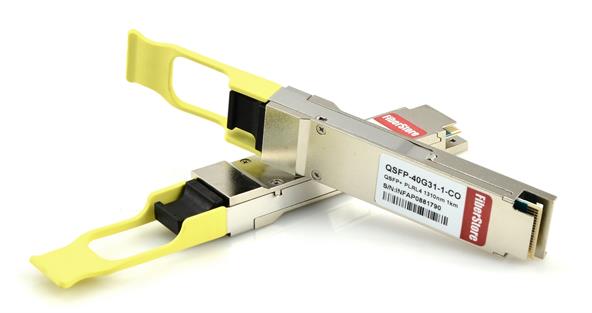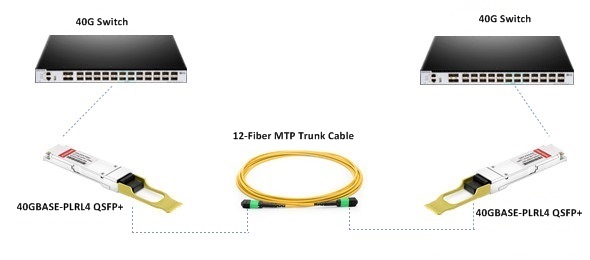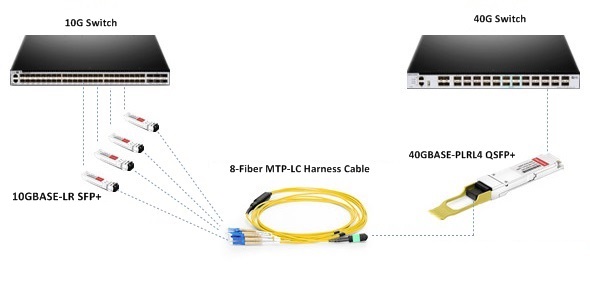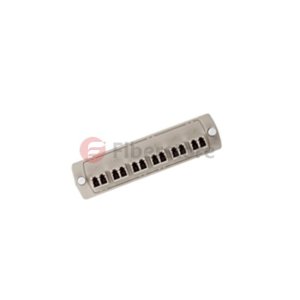Commonly, QSFP+ transceiver designed with LC interface works with single-mode fiber for long distance application, while QSFP+ transceiver with MTP/MPO interface is used over multimode fiber for short distance transmission. For instance, 40GBASE-ER4 QSFP+ is designed with LC duplex interface, and it supports maximum transmission length of 40 km over single-mode LC duplex fiber; 40GBASE-SR4 QSFP+ with MTP/MPO interface supports a transmission distance no more than 150m over multimode fiber. However, in order to meet user’s diverse needs in real applications, some 40G transceivers are designed not following this rule, like 40GBASE-PLRL4 (parallel LR4 Lite). This transceiver is with MTP/MPO interface design but is used over single mode fiber for long distance transmission. This article will introduce the MTP/MPO specifications for this transceiver and its deployment cases.

MTP Specifications for 40GBASE-PLRL4 QSFP+
QSFP-40G-PLRL4 transceiver uses MTP-12 interface to achieve parallel transmission, supporting maximum data links up to 1.4 km. The cable type required for 40GBASE-PLRL4 is an APC (angle polished connector) single-mode MTP-12 cable. The cable is similar to the 40G-SR MTP or MPO, with the only change being the use of single-mode fiber. UPC (ultra-polished connector) is another type of connector for MTP-12 cables, but it is not suited for single-mode fiber in the market. APC is the only available type for single-mode MTP-12 fiber. The MTP-12 connector plugged into the QSFP-40G-PLRL4 transceiver carries the 40G signal over only 8 of the 12 fibers, remaining four fibers unused, and these four can optionally be not presented in the cable for an economic reason. The used 8 fibers are mapped as 4x10G Tx and Rx pairs. In addition, the MTP cables connected to QSFP-40G-PLRL4 transceiver can be either MTP trunk cables or MTP splitter cables.
Deployment of 40GBASE-PLRL4 QSFP+
The QSFP-40G-PLRL4 is optimized to guarantee interoperability with any IEEE 40GBASE-LR4 and 10GBASE-LR. So when the link for 40G network and 10G to 40G migration is less than 1.4 km, it will be very appropriate to use 40GBASE-PLRL4 QSFP+ transceiver with single-mode MTP cables.
In the first case, you can choose an MTP trunk cable together with the 40GBASE-PLRL4 QSFP+ module for direct 40G connection. The following picture shows two 40GBASE-PLRL4 QSFP+ transceivers connected by a single-mode 12-fiber MTP trunk cable.

In the second case, you can simply use an 8-fiber MTP to 4xLC duplex harness cable with one 40GBASE-PLRL4 QSFP+ and four 10GBASE-LR SFP+ to achieve 10G to 40G.

You can see in the above two cases, MTP cable plays an important role and due to the special requirements of 40GBASE-PLRL4 for single-mode MTP fiber, it is necessary to choose the right MTP products connected to this 40G QSFP+.
Conclusion
40GBASE-PLRL4 QSFP+ module has special interface design which can be only compatible with single-mode MTP connector. During the deployment of 40GBASE-PLRL4 QSFP+ module, selecting proper MTP assemblies are essential to successfully accomplish the link. FS.COM is a professional fiber optic transceiver vendor and MTP product manufacturer, supplying compatible 40GBASE-PLRL4 QSFP+ transceiver of different brands, such as Cisco, Arista, Brocade, Huawei, etc. Also, other customized compatible brands are available for your requirements. MTP cables and assemblies are available for same-day shipping at low prices, including customized 8 fibers MTP/MPO trunk cable. You will be surprised to see how many kinds of network devices FS.COM can offer and you will get more than cost-effective products but also impressive service.

